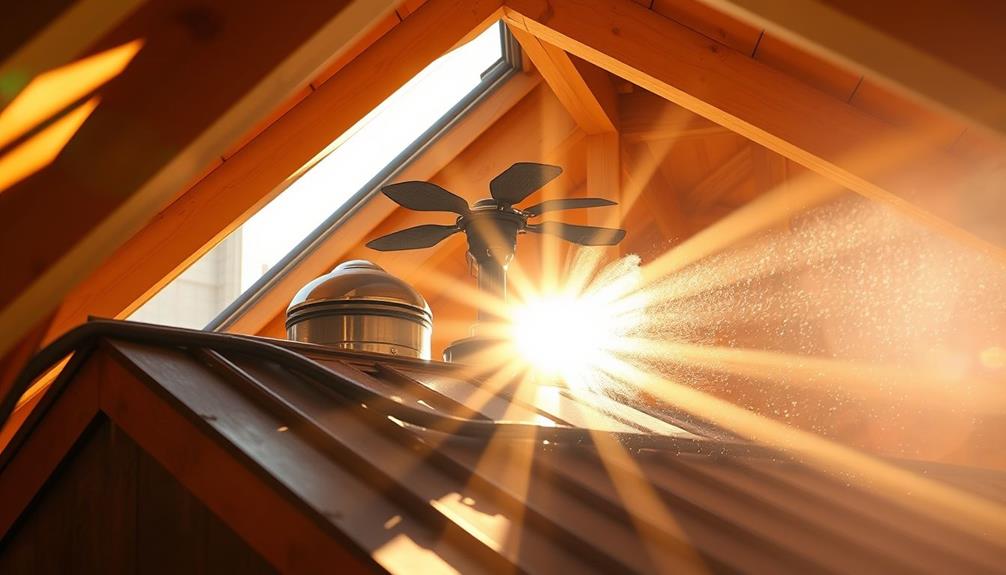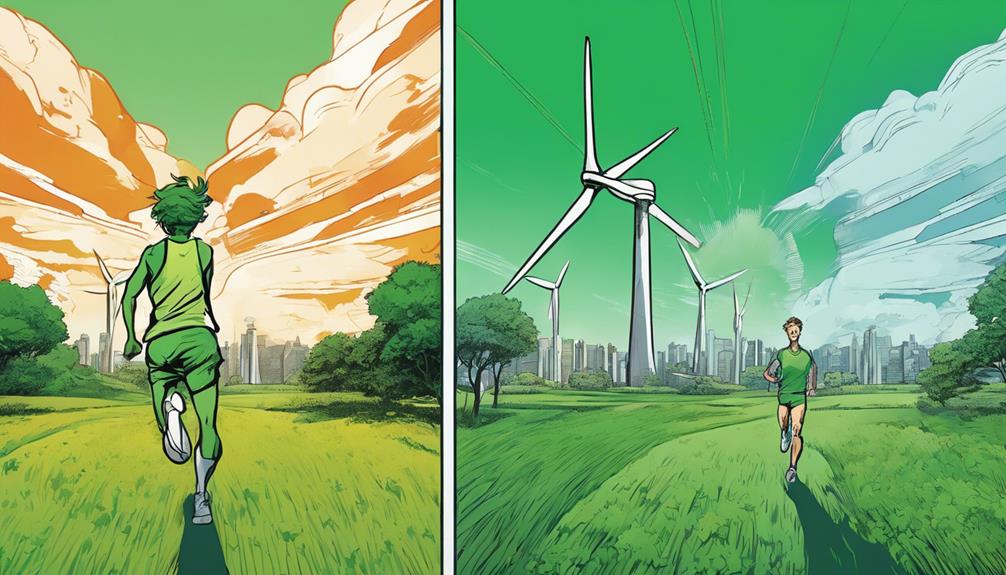Solar attic fans can truly make a difference in your home. They work by using solar energy to reduce attic temperatures, which helps lower your cooling costs by 10-30%. This not only eases the burden on your air conditioning unit but also can extend its lifespan. These fans perform best in sunny conditions, effectively promoting ventilation and preventing moisture buildup. While there may be some limitations, like reliance on sunlight and initial installation costs, the long-term benefits often outweigh them. Curious about what other aspects you should consider? Keep exploring to uncover more insights!
Key Takeaways
- Solar attic fans significantly reduce attic temperatures, leading to energy savings of 10-30% on cooling costs during hot months.
- They operate on solar energy, incurring no electricity costs and contributing to a lower carbon footprint.
- Performance is best in sunny climates; effectiveness diminishes in shaded or cloudy areas.
- Installation is straightforward, with no need for wiring, though initial costs can be higher than electric fans.
- Users report long-term benefits, including reduced energy bills and improved home comfort over time.
Understanding Attic Ventilation
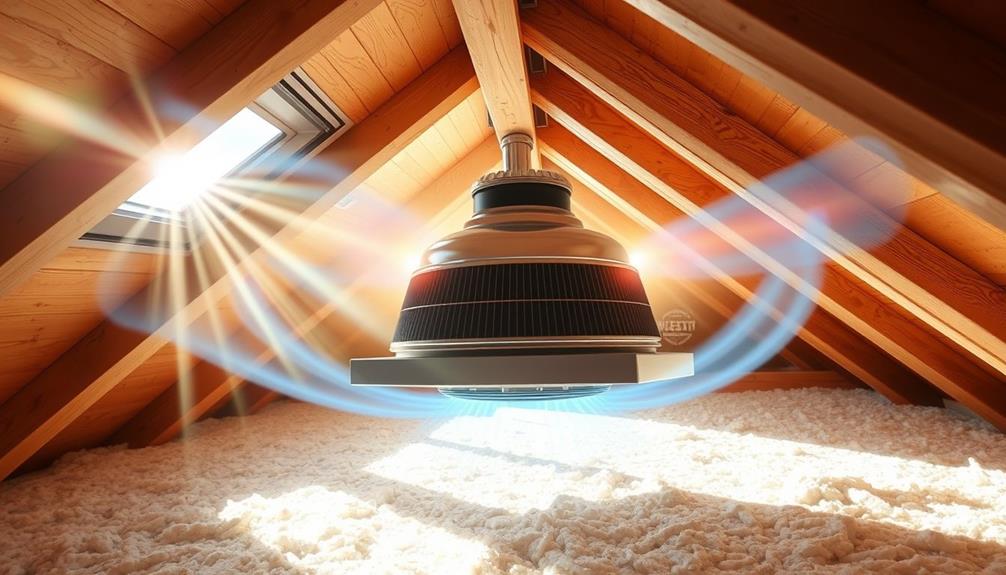
Understanding attic ventilation is vital for maintaining a comfortable and energy-efficient home. Proper attic ventilation helps regulate temperatures, preventing your attic from overheating during summer months. When your attic stays cooler, it reduces the workload on your air conditioning system, which can lead to energy savings of 10-30%. This decrease in cooling demand not only lowers your energy bills but also extends the lifespan of your HVAC system.
Additionally, incorporating advanced technology in your ventilation system can enhance its effectiveness, similar to the benefits of energy-efficient models in heat pumps.
Effective attic ventilation involves a balanced airflow design that incorporates both powered and passive methods. Solar fans play an important role in this process by expelling hot, stale air and pulling in cooler air from eave vents. This exchange helps to prevent heat and moisture buildup, which can lead to mold growth and structural damage over time.
Additionally, maintaining a well-ventilated attic prolongs the life of your roofing materials, saving you money on future replacements.
Investing in a good attic ventilation system, including solar fans, is a smart choice for any homeowner looking to enhance comfort and achieve significant energy savings. By keeping your attic well-ventilated, you create a healthier living environment and protect your home's structural integrity.
How Solar Attic Fans Work
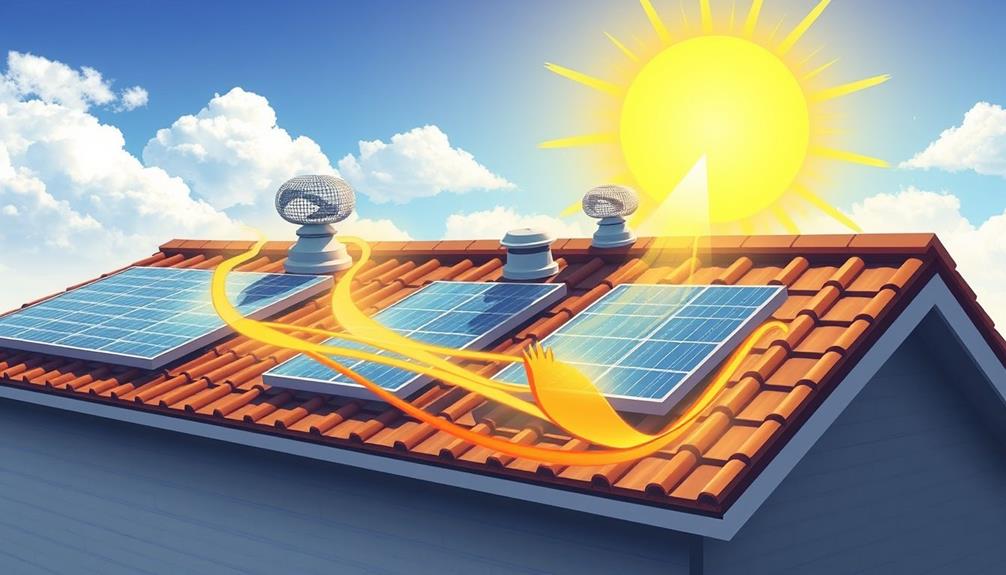
Harnessing the power of sunlight, solar attic fans operate by converting solar energy into electricity to efficiently expel hot air from your attic.
These solar fans feature photovoltaic panels that capture sunlight, generating the energy needed to power the fan. Positioned near the peak of your roof, they facilitate air exchange by drawing in cooler air from eave vents while pushing out stale hot air from the attic space.
With airflow rates between 300-500 cubic feet per minute (CFM), these fans considerably reduce attic temperatures, helping to alleviate the load on your air conditioning system. This reduction in heat buildup not only enhances indoor comfort levels but also prolongs the lifespan of your roofing materials.
Additionally, efficient energy solutions like solar attic fans contribute to renewable energy goals by utilizing clean energy and reducing reliance on conventional power sources.
However, the efficiency of solar attic fans can be hindered by shading; they perform best when exposed to direct sunlight, especially in sunny regions like Florida.
Types of Solar Attic Fans
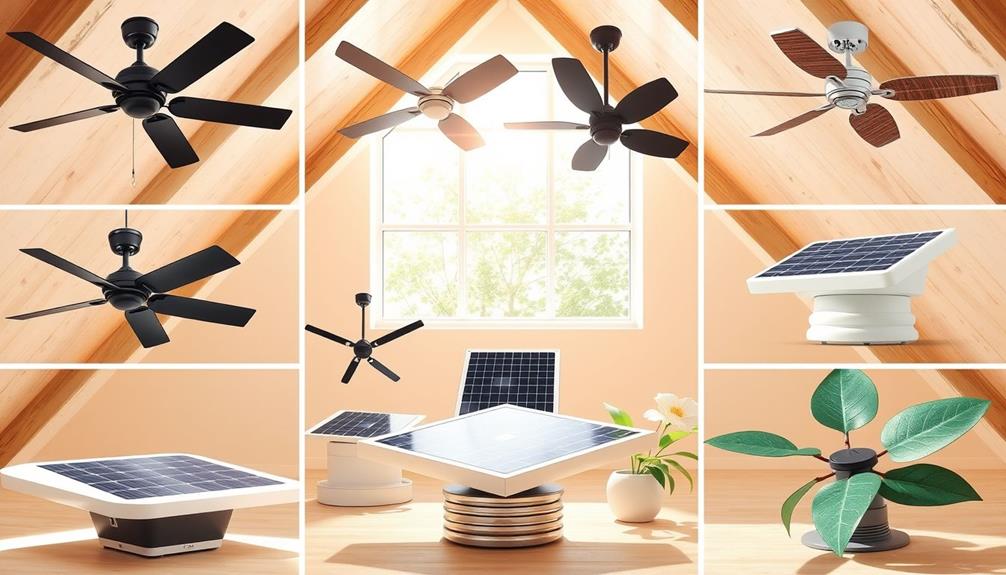
When considering solar attic fans, you'll find two main types: roof-mounted and gable-mounted options.
Each type has its own advantages, especially when comparing them to electric fans. Understanding the importance of nurturing an imaginative mindset can help you visualize the best fit for your home.
Plus, their performance can vary considerably based on your climate and sunlight exposure, so it's crucial to choose wisely.
Solar Vs. Electric Fans
While both solar and electric attic fans serve the purpose of enhancing airflow and reducing heat buildup in your attic, they differ considerably regarding operation and efficiency.
Solar attic fans operate on photovoltaic energy, making them energy-efficient and eco-friendly, which aligns with the trend towards sustainable home improvements like best vacuums for dust removal. In contrast, electric fans draw power from the grid, which can increase your electricity costs.
When it comes to airflow, electric fans typically deliver over 1200 CFM, whereas solar fans provide an airflow rate of 300 to 500 CFM. So, if you need more powerful air movement, electric fans might be the way to go.
Additionally, solar attic fans are easier to install since they require no wiring, while electric fans necessitate hardwiring and a thermostat.
Consider the performance aspect as well: solar attic fans depend on direct sunlight, which limits effectiveness on cloudy days or in shaded areas. Electric fans, however, operate consistently regardless of weather conditions.
Finally, solar fans can help reduce cooling costs by up to 30% over time, while electric fans may incur ongoing operational costs averaging around $24.30 annually.
Roof and Gable Options
Choosing the right type of solar attic fan can greatly impact your home's ventilation efficiency. Roof-mounted fans are typically placed near the peak of your roof, maximizing airflow and markedly reducing attic temperatures. This placement helps lower cooling costs and extends the lifespan of your roofing materials.
Additionally, proper ventilation is essential in preventing moisture buildup, which can lead to mold and structural damage; in fact, aquatic exercise is a great analogy for how balanced airflow can improve overall health.
On the other hand, gable-mounted fans are installed in the gables behind louvered vents. They work effectively when paired with soffit or roof vents, creating balanced airflow, making them ideal for structures like greenhouses and garages.
Both roof and gable-mounted fans utilize solar panels, making them an eco-friendly choice that reduces reliance on traditional electricity sources. These fans boast airflow rates between 300 to 500 CFM, enhancing attic ventilation and providing relief in sunny climates.
Larger solar panels on these fans enhance efficiency, particularly in areas with abundant sunlight, allowing them to combat heat buildup effectively.
When considering your options, think about your specific needs, as the right choice can make a considerable difference in your home's overall comfort and energy efficiency.
Performance in Different Climates
Understanding how solar attic fans perform in different climates can help you make an informed decision for your home. In sunny climates, these fans shine, harnessing solar energy to reduce attic temperatures and improve ventilation efficiency.
Additionally, incorporating multi-functional gear in your home can enhance overall energy efficiency. You'll find that they can provide airflow rates of 300-500 CFM, which is often sufficient for cooling in these conditions.
However, if you live in a cloudy or shaded area, the performance of solar attic fans may drop, making it necessary to contemplate supplemental cooling solutions. During prolonged periods of cloud cover, their effectiveness can wane, potentially leaving you with insufficient cooling during extreme heat.
In humid climates, solar attic fans are particularly beneficial as they help control moisture levels, preventing mold growth.
But again, their performance can struggle under extended cloudy conditions.
Ultimately, it's essential to evaluate your local climate when investing in solar attic fans. Sunlight availability and seasonal weather patterns play significant roles in their effectiveness, so examining these factors can help you choose the right solution for your home's ventilation needs.
Benefits of Solar Attic Fans
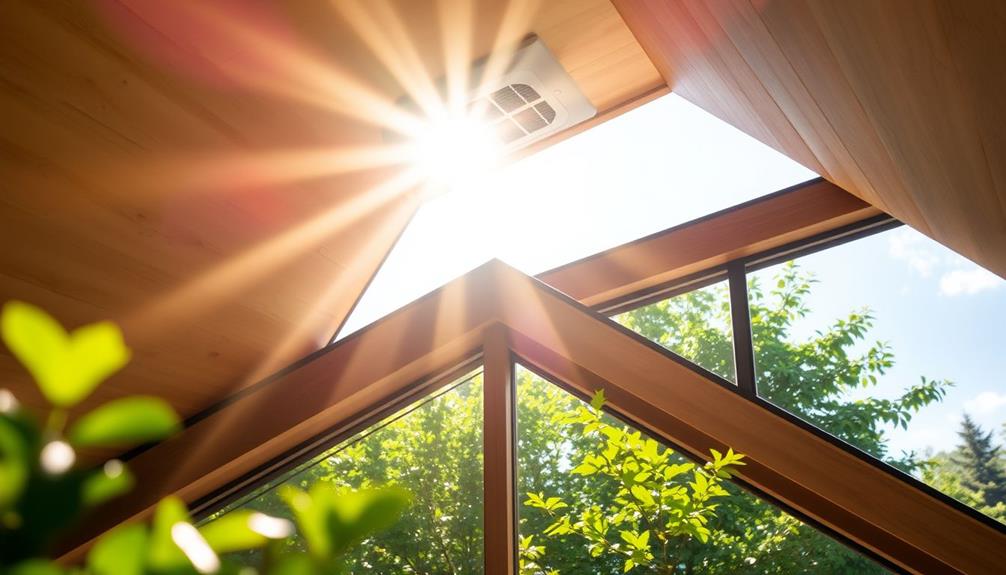
Installing solar attic fans offers numerous benefits that can enhance your home's energy efficiency and overall comfort. These fans operate on solar energy, which means you won't incur electricity costs while reducing your carbon footprint. By considerably lowering attic temperatures, you can enjoy energy savings of 10-30%, especially in sunny climates like Florida.
Here's a quick breakdown of the benefits:
| Benefit | Description | Impact |
|---|---|---|
| Energy Efficiency | Reduces attic temperatures, lowering AC costs | 10-30% energy savings |
| Mold Prevention | Lowers moisture levels, preventing mold growth | Healthier indoor air |
| Roof Longevity | Prevents heat buildup, extending roofing material life | Slows shingle deterioration |
In addition to these advantages, the installation of solar attic fans can pay for itself within 3-5 years thanks to energy savings and potential rebates. By investing in this eco-friendly solution, you're not only improving your home's comfort but also contributing to a sustainable future.
Limitations of Solar Attic Fans
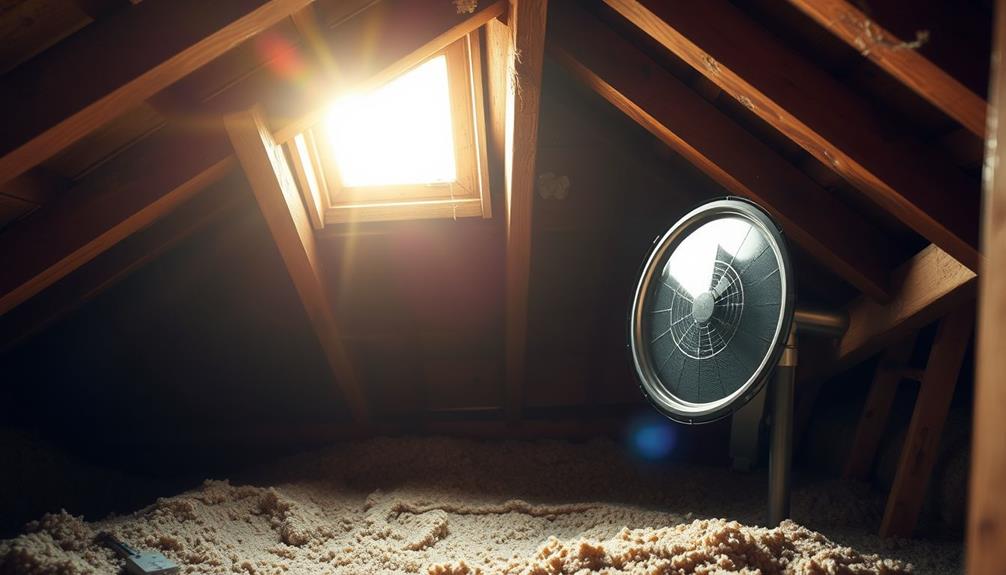
While solar attic fans offer great benefits, you should consider some limitations before investing. They rely heavily on direct sunlight, which can hinder performance in shaded areas or cloudy weather.
Additionally, if you're dealing with high-purine items and want to maintain a healthy environment in your attic, the impact of temperature and humidity shouldn't be overlooked, as they can affect overall air quality and comfort levels common types of cold medications.
Plus, the initial cost can be higher than traditional fans, raising concerns about your budget and return on investment.
Initial Cost Concerns
Although solar attic fans promise long-term energy savings, the initial cost can be a significant hurdle for many homeowners. Typically, the installation cost ranges from $150 to $600, which is often higher than traditional electric fans that can be about $300 less.
Furthermore, if you need multiple solar attic fans for effective air movement, those upfront expenses can quickly add up. This is especially important to take into account when creating a personal budget, as expense categorization can help in managing these costs effectively.
Reflect on these important factors:
- Upfront Expenses: The cost of purchasing and installing multiple solar attic fans can strain your budget.
- Return on Investment: The average annual savings for a 1,000 sq ft home is around $40, meaning it could take several years to break even on your investment.
- Long-Term Commitment: If you're not ready to wait for the ROI, the initial cost mightn't seem worth it, especially if you live in an area with limited sunlight.
While solar attic fans can save you money on energy bills over time, their initial cost might deter many homeowners from making the switch. It's crucial to weigh these financial factors against the potential benefits before deciding.
Sunlight Dependence Issues
Solar attic fans often struggle to deliver consistent performance due to their reliance on sunlight. They need sunlight to work, which means their effectiveness drops considerably on cloudy days or in shaded areas. This limited effectiveness can leave your attic hot and stuffy, especially during peak summer months.
Additionally, just like the importance of proper diet and cage setup in hamster care, effective attic ventilation requires careful planning to guarantee ideal airflow. While these fans typically move air at 300 to 500 CFM, that's far less than electric fans that can push over 1200 CFM, creating performance limitations that mightn't meet your ventilation needs.
Since solar fans only operate when the sun shines, they won't provide ventilation during evenings or on overcast days. This means you might find yourself needing to install multiple solar attic fans to achieve adequate airflow, leading to a higher initial investment.
Plus, in regions with inconsistent sunlight, it can take several years to break even on that investment, raising questions about their overall cost-effectiveness.
Installation Process and Considerations
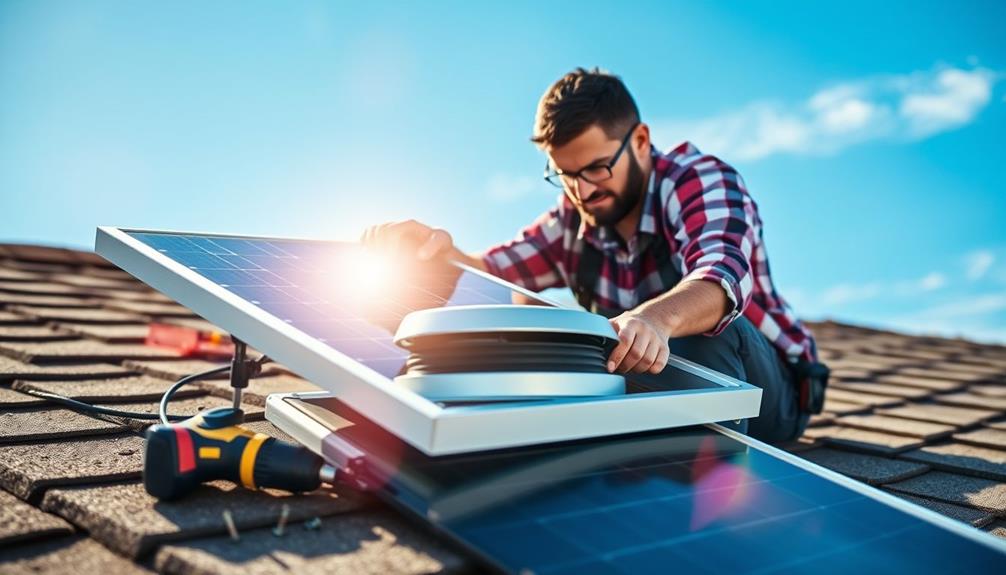
Installing a solar attic fan can be a straightforward project, requiring just a few basic tools and minimal time. You'll typically mount it on the roof or gable, which simplifies the installation process. However, there are some important considerations to keep in mind to guarantee a successful installation.
1. Local Building Codes: Before starting, check your area's regulations to confirm compliance with local building codes. This is essential for safety and efficiency.
Additionally, air quality considerations can impact how effective your attic fan will be in maintaining a comfortable home environment.
2. Location and Positioning: Choose a spot that receives ample sunlight throughout the day. Roof-mounted fans are common, but make sure they're positioned to maximize solar exposure.
3. Tools and Materials: Gather necessary tools like a drill, screwdriver, and a saw, along with your solar attic fan kit. Having everything ready will streamline the installation.
Regular maintenance is critical too. Clean the solar panels periodically and inspect the fan housing for any debris.
This not only helps maintain performance but also extends the lifespan of your solar attic fans. By following these guidelines, you can guarantee a seamless installation process that enhances your home's ventilation.
Cost Analysis and Savings
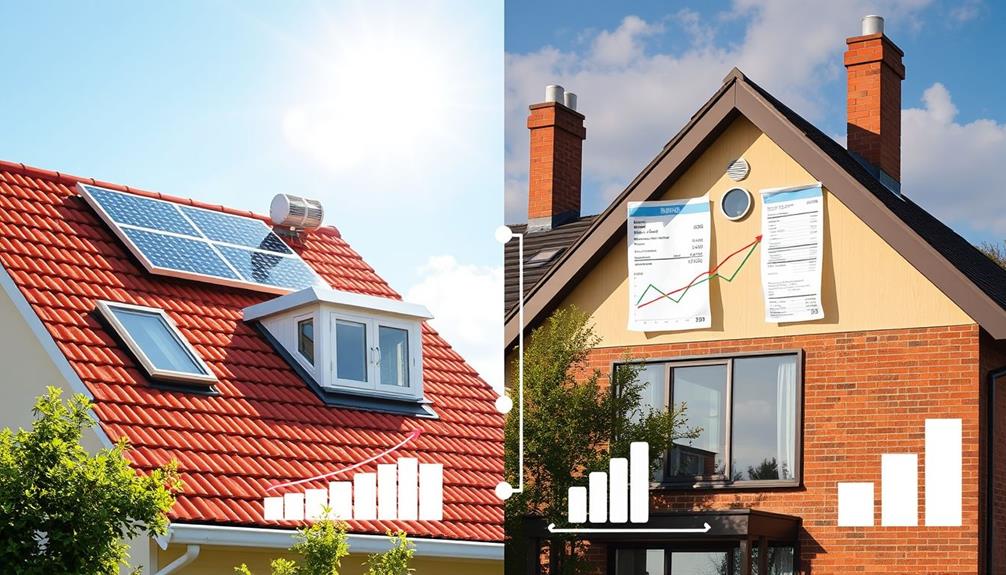
When considering a solar attic fan, you'll find that initial costs generally range from $150 to $600, with additional installation expenses of $150 to $300. This upfront investment is part of a broader cost analysis you should conduct.
While the initial costs may seem high compared to traditional electric fans, solar attic fans come with significant long-term savings. The average payback period is typically between 3 to 5 years, with potential reductions in your electric bill of 10% to 30%.
For a 1000 sq ft home, you could save around $40 annually, although this can vary based on your local climate and the size of your home. If you have a larger home, consider installing multiple units to maximize airflow and cooling efficiency.
One of the standout benefits of solar power is that these fans have no ongoing operational expenses. Once installed, they rely solely on the sun, which translates into consistent savings over their lifespan.
Customer Experiences and Feedback
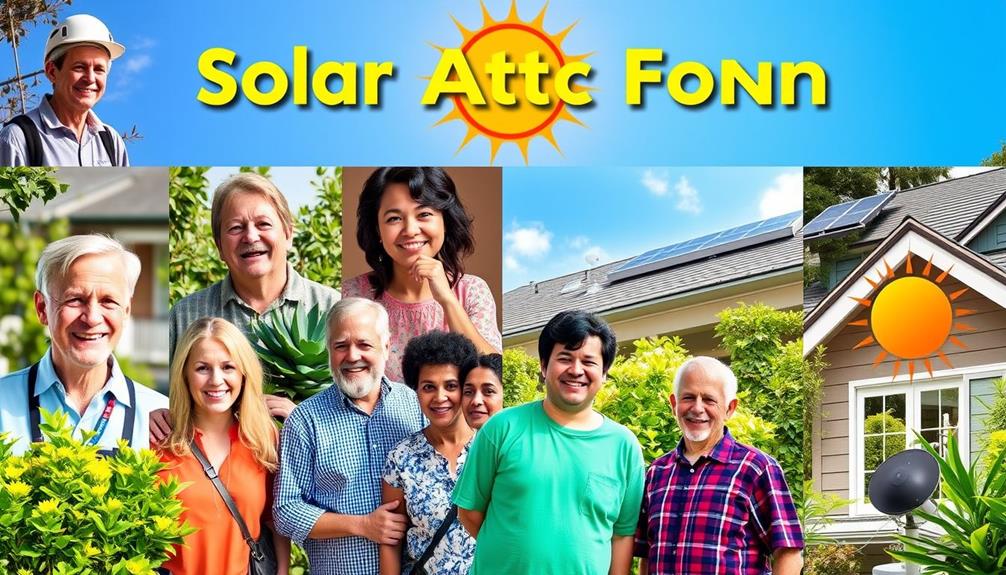
When you install a solar attic fan, you might find the process smooth and straightforward, thanks to knowledgeable technicians.
Many customers share that the fan performs exceptionally well during the hot summer months, keeping their attics cool and comfortable.
Plus, over time, you'll likely notice long-term benefits, like reduced energy costs and improved overall home efficiency.
Installation Process Insights
Though many homeowners may feel intimidated by the thought of installation, feedback shows that setting up solar attic fans is often a straightforward experience.
Most customers report that the process requires minimal tools and involves mounting the fan on the roof or gable for maximum airflow.
Here are three key insights from customer experiences regarding the installation process:
- Professionalism: Technicians are often described as courteous, knowledgeable, and professional, contributing to a high level of satisfaction throughout the installation.
- Efficiency: Many users appreciate how efficient and clean the installation process is, with technicians maintaining a tidy work area, which helps minimize disruption.
- Transparent Costs: The average installation costs for solar attic fans range from $150 to $300.
Customers find this investment worthwhile, given the long-term energy savings they can achieve.
Performance During Summer
Many homeowners have found that solar attic fans dramatically enhance their summer experience by considerably lowering attic temperatures. Customers report a decrease in air conditioning costs by about 10-30%, making these attic fans a smart investment. You'll likely notice a significant difference in indoor comfort levels as these fans efficiently remove hot air from your attic, improving overall home ventilation.
Here's a quick overview of customer experiences with solar attic fans during summer:
| Customer Feedback | Impact on Home |
|---|---|
| Reduces attic temperatures | Lower air conditioning costs |
| Operates silently | Improved comfort without noise |
| Consistent performance in sun | Reliable airflow in hot weather |
| Enhances ventilation | Better indoor air quality |
| Depends on sunlight exposure | Ideal panel placement needed |
If you live in a sunny region, you might find these solar attic fans maintain consistent performance, even during peak summer temperatures. Just remember, the efficiency of your solar attic fans will depend on proper panel placement to maximize exposure to sunlight. Overall, many users feel that these fans are a worthy addition to any home.
Long-Term Benefits Observed
After experiencing the immediate benefits of solar attic fans during the summer, you might be curious about their long-term advantages. Many customers have shared positive experiences that highlight how these fans continue to enhance comfort and efficiency over time.
Here are three key long-term benefits you can expect:
- Lower Energy Costs: Users report a 10-30% reduction in air conditioning expenses, thanks to attic fans that remove hot air and allow fresh air to circulate, making your home more energy-efficient.
- Improved Indoor Air Quality: By helping to reduce humidity levels, solar attic fans greatly decrease the risk of mold and allergens, leading to a healthier living environment.
- Eco-Friendly Operation: Customers appreciate that these fans utilize renewable solar energy, helping to reduce their carbon footprint while providing a sustainable solution for home ventilation.
Comparing Solar and Electric Fans
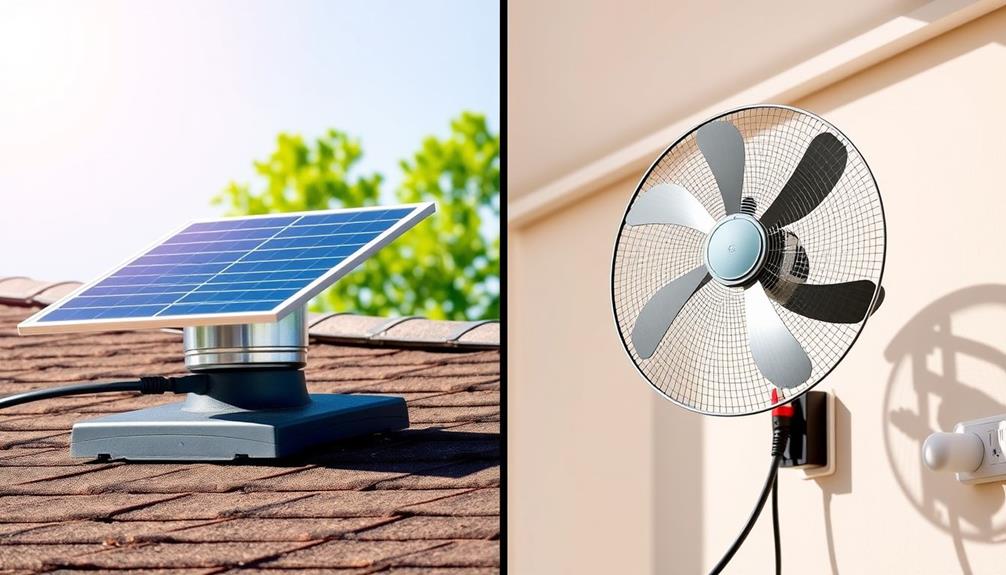
When choosing between solar and electric attic fans, it's crucial to weigh their distinct advantages and limitations. Solar attic fans harness solar energy, offering an airflow of 300-500 CFM without any operational cost, making them a cost-effective choice. In contrast, electric fans can deliver over 1200 CFM but consume around 200W each, resulting in an annual operating cost of about $24.30.
Here's a quick comparison to help you decide:
| Feature | Solar Attic Fans | Electric Fans |
|---|---|---|
| Energy Source | Solar energy | Electricity |
| Airflow (CFM) | 300-500 | Over 1200 |
| Operating Cost | $0 | ~$24.30/year |
| Weather Dependency | Effective in sunny areas | Operates in any weather |
While solar attic fans are perfect for sunny climates, their effectiveness can drop in shaded or cloudy areas. Electric fans, however, work regardless of weather conditions. The initial investment for solar fans may be higher, but their long-term savings on energy consumption can lead to a payback period of 3-5 years, making them an economically viable option over time.
Maintenance and Longevity Tips
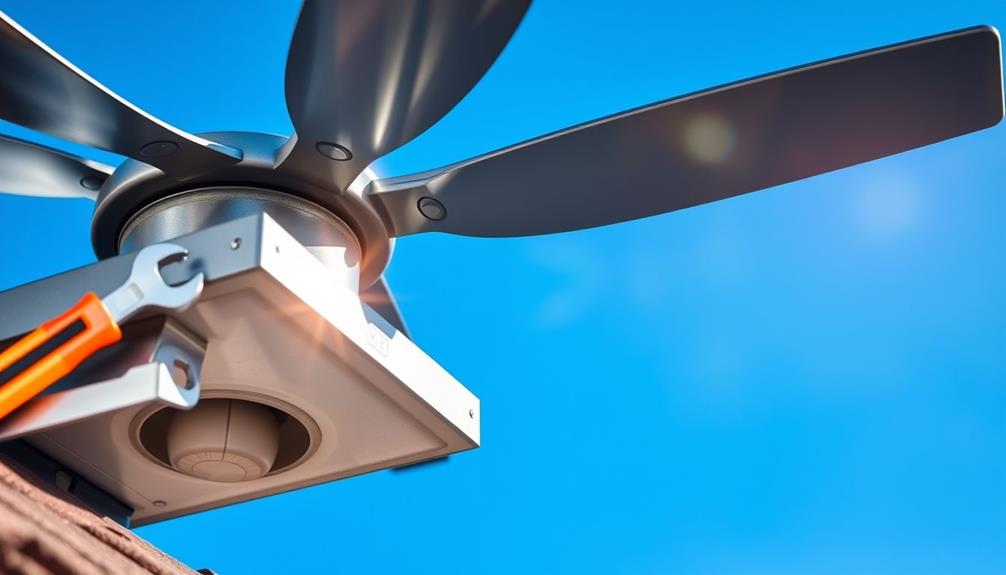
To keep your solar attic fan running efficiently, regular maintenance is key. By following a few simple steps, you can enhance the longevity of your fan and guarantee it performs at its best.
- Clean the Solar Panels: Regularly clean the solar panels to remove dirt and debris. This maintenance task is essential since buildup can greatly reduce efficiency.
- Inspect the Fan Housing: Periodically check the fan housing for obstructions like leaves or nests. This inspection helps maintain smooth operation and prevents potential damage.
- Check Electrical Connections: Verify all electrical connections are secure and that the solar panel is properly mounted. Addressing these installation details can greatly enhance your solar attic fan's lifespan.
While most solar attic fans have a lifespan of 25 years or more, factors such as installation quality and exposure to harsh weather can affect their durability.
Following local building codes during installation not only guarantees safety but also promotes the ideal performance of your solar attic fan.
Frequently Asked Questions
Are Solar Attic Fans Worth It?
If you're considering solar attic fans, they can be worth it. You'll likely notice reduced cooling costs and improved indoor comfort, especially in sunny areas. Just keep in mind their effectiveness depends on sunlight exposure.
How Much Does a Solar Attic Fan Help?
A solar attic fan helps considerably by reducing attic temperatures and improving ventilation. You'll notice lower cooling costs and extended roof life, plus it operates without electricity, making it a smart investment for your home.
What Are the Disadvantages of Solar Fans?
Solar fans can be costly to install and may require multiple units for effective ventilation. Their performance hinges on sunlight, and maintenance issues can arise, potentially delaying your return on investment for years.
Do Attic Fans Really Save Money?
Imagine dollar bills floating away in the heat. Attic fans can save you money by reducing cooling costs and extending your roof's life. You'll notice those savings stack up, especially in sunny climates.
Conclusion
In the end, solar attic fans can make a difference in your home's comfort and energy efficiency, but they're not a one-size-fits-all solution. If you're looking to reduce heat buildup and lower cooling costs, they're worth considering. Just remember to weigh their benefits against potential limitations and costs. By understanding how they work and exploring customer feedback, you can make an informed choice that suits your needs and helps keep your attic cool year-round.
